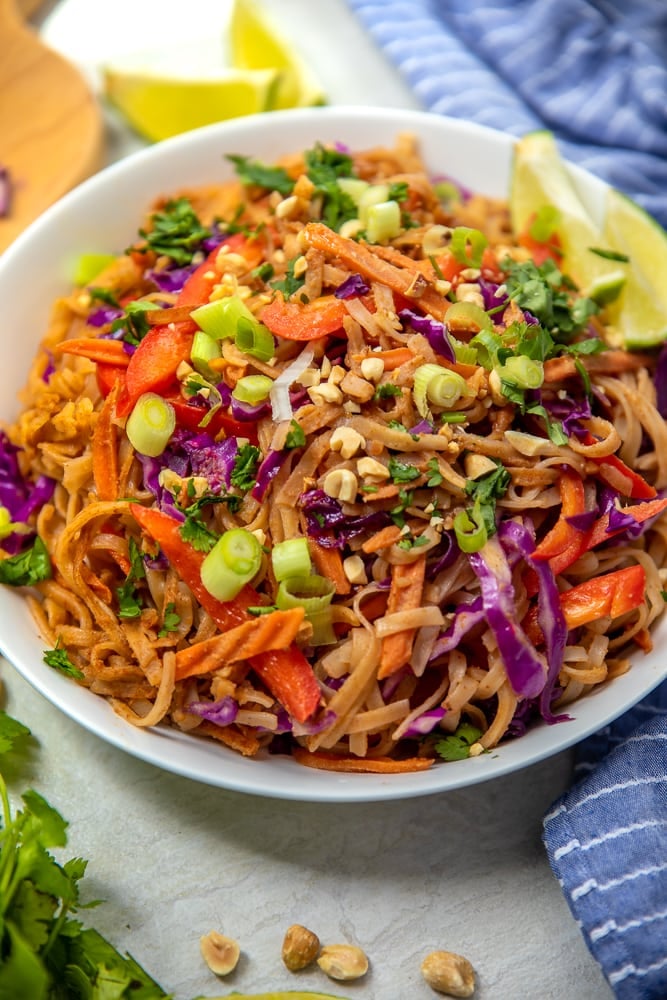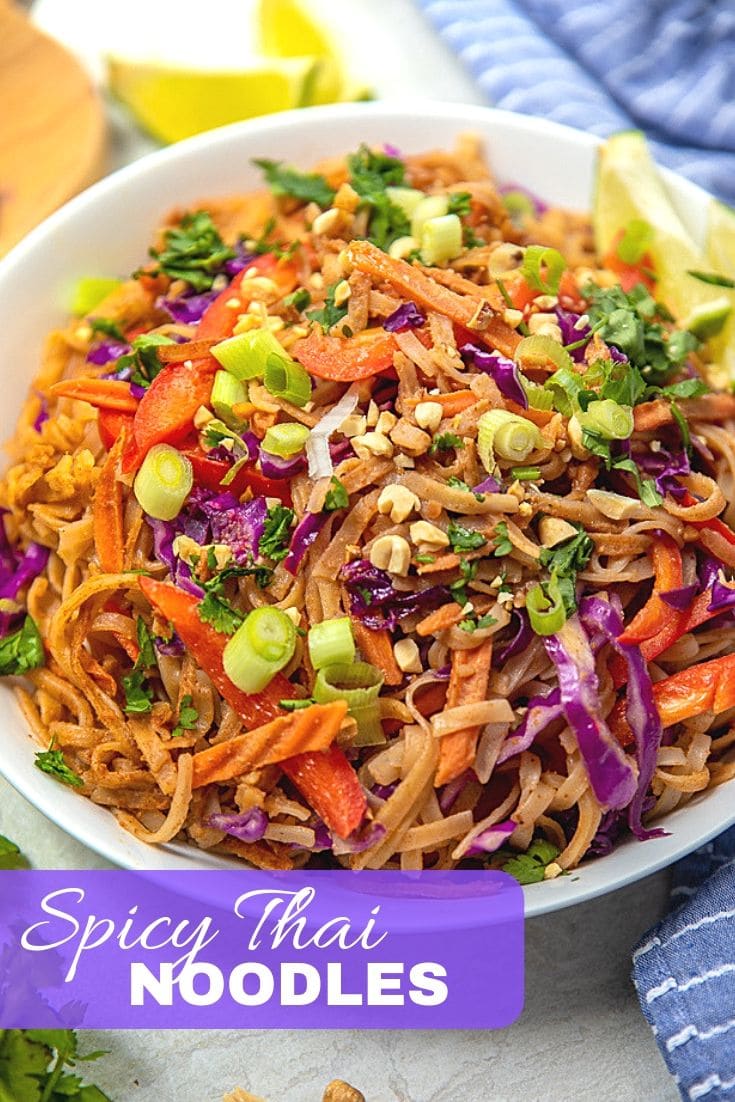Ready in just 15 minutes, Thai noodles are made with everyday ingredients and are insanely flavorful! This recipe for Thai-Inspired Noodles is vegetarian, vegan-friendly, and can easily be made gluten-free--but most importantly EVERYONE loves this recipe.

First, let me start by saying I know this recipe for Thai Noodles is NOT authentic, nor is it a recipe for Pad Thai Noodles, which is made with stir-fried rice noodles and tamarind, fish sauce, shrimp, and tofu. These Thai-Inspired Noodles are a healthy, vegetarian dish that is light and fresh and made with easy-to-find ingredients.
I developed this simple recipe after enjoying Thai Noodles out with friends at a local Thai restaurant. While we loved the flavors of the rice noodles and rich peanut sauce but we agreed the dish was a bit greasy, a bit too salty, and would be much more delicious with the addition of fresh vegetables, for crunch and for flavor.
So that is exactly what I have created. Noodles with a spicy peanut sauce and tons of fresh vegetables that have the same flavor profile as Thai Noodles, but are lower in fat, sodium, and most importantly, absolutely delicious.
Notes on Ingredients
This recipe for Thai Noodles is made up of four key components: noodles, peanut sauce, vegetables, and a crunchy, fresh topping made of peanuts, sesame seeds, and cilantro. Do not be intimidated by the long list of ingredients needed to make the homemade peanut sauce. Most of these are items you most likely have in your pantry and easily be found in any major grocery store.

- Rice Noodles: I recommend using Pad Thai rice noodles to make this noodle dish. The noodles are thicker and will hold the sauce better than thin rice noodles. If you can't find rice noodles, use linguine or spaghetti noodles in their place--this also cuts down on the cost of ingredients.
- Spicy Peanut Sauce: The star of this noodle dish is the slightly sweet, slightly spicy savory peanut sauce. To prepare the homemade peanut sauce, you will need the following ingredients.
- Oil: Just a small amount of neutral oil, such as canola or vegetable, to help keep the noodles from sticking together.
- Peanut Butter: An all-natural peanut butter without added oils or sugars is best for texture and taste, but shelf-stable peanut butter can be subbed if that is all you have on hand.
- Sesame Oil: Use toasted sesame oil, not regular sesame oil. Toasted sesame oil is designed to be used to flavor dishes, while regular sesame oil is for cooking. Tip: Be sure to store opened sesame oil in the fridge after use as it will go rancid quickly at room temperature.
- Soy Sauce: Be sure to select low-sodium soy sauce, to keep the sodium in check.
- For Heat: I add both crushed red pepper flakes and Sriracha sauce. Adjust to control the level of spiciness you prefer.
- Rice Wine Vinegar: This is the best vinegar to use for its mild, sweet flavor that balances out the peanut sauce. Mirin can be used in its place if desired.
- Honey: You need a bit of sweetness to round out the peanut sauce, and honey is my preferred choice. Maple syrup may be substituted.
- Lime Juice: Fresh lime juice is a must for acid and flavor, which will balance out the dish.
- Vegetables: You can opt to use whatever vegetables you like for this dish. I personally prefer a combination of green onions, broccoli, sugar snap peas, cabbage, bell peppers, and carrots. Other delicious options would be bean sprouts, mushrooms, or broccoli slaw.
- Cilantro: Feel free to omit it if you do not care for cilantro.
- Peanuts: Chopped, dry-roasted peanuts add crunch and texture to this noodle dish.
- Sesame Seeds: Sesame seeds are optional, but add crunch and flavor.
How to Make Thai Noodles
- Prepare the packaged noodles according to the package directions, as each brand of noodles will vary. Some brands of rice noodles will direct you to soak the noodles in boiling water, others will say to simmer in boiling water. If using linguine or spaghetti noodles, the directions will be drastically different than if preparing Thai Noodles with rice noodles.

- While the noodles are cooking prepare the peanut sauce by mixing together the sesame oil, peanut butter, soy sauce, red pepper flakes, vinegar, sriracha, honey, lime juice, minced garlic, and a bit of the oil until well combined. Set aside.

- Toast peanuts and sesame seeds in a dry skillet over medium-high heat for 2-3 minutes, or until slightly toasted. This is CRUCIAL for developing the most flavor out of the nuts and sesame seeds and makes a world of difference. Remove the nuts and seeds from the skillet and set them aside to cool.

- Once the noodles are cooked, drain and rinse the noodles. I normally do not recommend rinsing pasta but rice noodles release a lot of starch and if that starch is not removed, the noodles will stick together completely. If using spaghetti or linguine noodles, simply drain the pasta, there is no need to rinse these types of noodles.
- Place the noodles into a large mixing bowl and toss them with a bit of canola oil, which will prevent the noodles from sticking together. DO NOT SKIP THIS STEP! Rice noodles are very sticky and if you don't add some oil, they WILL clump together.

- Pour the peanut sauce over the noodles and toss to evenly coat the noodles with the sauce.
- Add in any vegetables you are using, along with the minced cilantro, and toss again to combine.

- Sprinkle with chopped peanuts and sesame seeds and serve.

Storage Instructions
Thai Noodles are best if served immediately after preparation, as the rice noodles quickly soak up the peanut sauce as they sit. However, you can prepare this dish up to 24 hours before serving. I recommend preparing the recipe as directed, up to adding the nuts and sesame seeds. Cover and refrigerate for up to 24 hours. Before serving, add a splash of water or vegetable broth to loosen up the noodles, and then top the nuts and sesame seed right before serving.
Recipe Modifications
- Vegan Thai Noodles: Use maple syrup in place of honey and this dish becomes vegan-friendly.
- Gluten-Free Thai Noodles: Use certified gluten-free rice noodles and Tamari or gluten-free soy sauce.
- Control the Heat: If you are serving Thai Noodles to sensitive palates or small kids, serve the Sriracha sauce on the side instead of mixing it into the peanut sauce. Let those who like spice add it to the noodles themselves upon serving.
- Veggie Choices: While I love the contrast of fresh vegetables in this noodle dish, feel free to use Feel free to use quickly blanch or steam the vegetables for a softer texture.
- Add Protein: Make these Thai Noodles a hearty main course by adding steamed edamame, sauteed shrimp, scrambled eggs, cubed tofu, or leftover diced chicken.
More Easy Asian-Inspired Recipes
- Easy Fried Rice
- Stir-Fried Chicken and Bok Choy
- Simple Chicken Asparagus Stir Fry
- Instant Pot Mongolian Beef
- Spring Rolls
- Chicken Katsu
Need more inspiration for planning meals that your family will love? Sign up for my FREE Meal Plans and each week you will get a meal plan with a shopping list.
If you enjoyed this simple recipe for Peanut Thai Noodles, please be sure to leave a comment and review below.

Easy Thai Noodles
Ingredients
- 8-9 ounce package of rice noodles
- 1 tablespoon canola oil divided
- 2 teaspoons sesame oil
- ¼ cup low sodium soy sauce
- ¼ tsp. crushed red pepper flakes optional
- 1 tablespoons rice vinegar
- 1 teaspoon hot sauce (like Sriracha) more or less to taste
- ¼ cup smooth peanut butter
- 2 tablespoons honey
- 1 tablespoon lime juice from fresh limes
- 2 cloves garlic minced
- 1 green onion minced
- 1 cup sugar snap peas
- 1 red bell pepper thinly sliced
- 1 carrot julienned
- 1 cup red cabbage thinly sliced
- ¼ -⅓ cup cilantro chopped
- ¼ cup dry roasted peanuts
- 2 tablespoons sesame seeds toasted
Instructions
- Prepare rice noodles (or pasta noodles) according to package directions. It is very important to follow the package directions as some brands work best soaking noodles in boiling water for a couple minutes and others need to be simmered in boiling water.
- While pasta is cooking, mix together ½ tablespoon canola oil, sesame oil, soy sauce, rice vinegar, hot sauce, lime juice peanut butter, honey, minced garlic, and red pepper flakes. Whisk vigorously until smooth.
- Toast peanuts and sesame seeds in a dry skillet over medium-high heat for 2-3 minutes, or until slightly toasted. This is CRUCIAL for developing the most flavor out of the nuts and sesame seeds and makes a world of difference. If your peanuts/sesame seeds say dry-roasted or toasted, skip this step!
- Drain the noodles and rinse well. Place noodles in large mixing bowl and immediately toss the noodles with the remaining ½ tablespoon canola oil to coat. This keeps the noodles from sticking together!
- Add the peanut sauce, peppers, green onions, carrots, broccoli, sugar snap peas, cabbage, cilantro to the noodles, and toss well. Top with the chopped nuts and sesame seeds.
- Serve immediately for best results.
Notes
Nutrition
This recipe was originally published in 2019 and updated in 2022 with a video and new process shots.



Carol
Is this recipe meant to be served warm or cold or either way. It looks delicious. Thanks
Kristen Chidsey
I love it both ways!
Cheryl Evans
Great vegetarian meal! I added some ginger just because I love it, and was delicious.
Kristen Chidsey
Thank you for sharing, Cheryl! I am thrilled to hear you enjoyed and I agree, extra ginger doesn't hurt!
Jonny
I really liked this and so did the family!
I added ginger, fish sauce, as well as Napa cabbage & ground turkey.
Excellent
Kristen Chidsey
I am so happy to hear you enjoyed so much! I love the idea of adding ground turkey as well.
Renee
OMG! So delicious! I sauteed my veggies and added some chicken. Yum!
Kristen Chidsey
Thanks for sharing, Renee!
JEN
I love this. THANK YOU!!!!! Your website is super helpful!!!!!
Kristen Chidsey
You are so welcome, Jen! Thanks for the kind compliments!